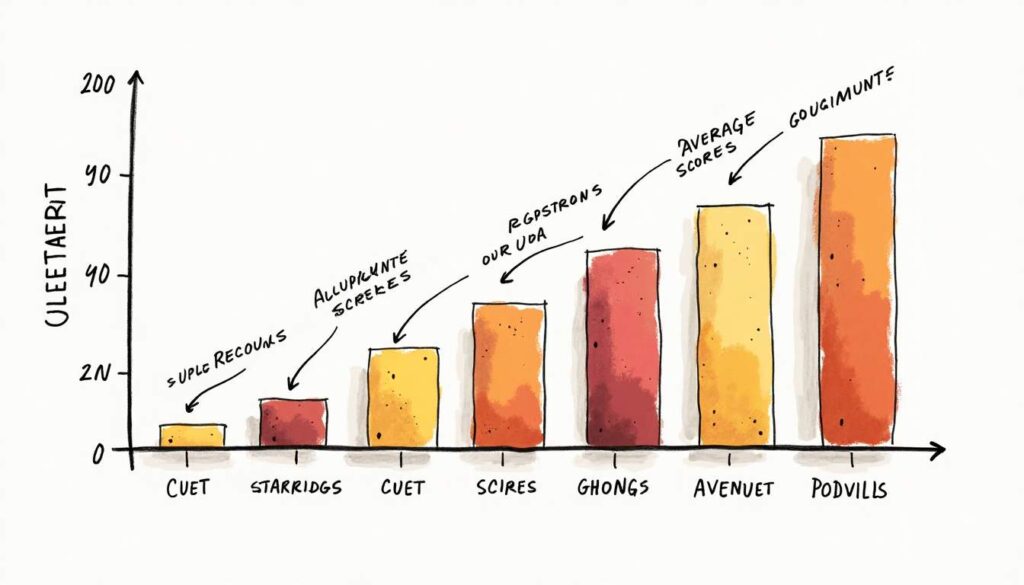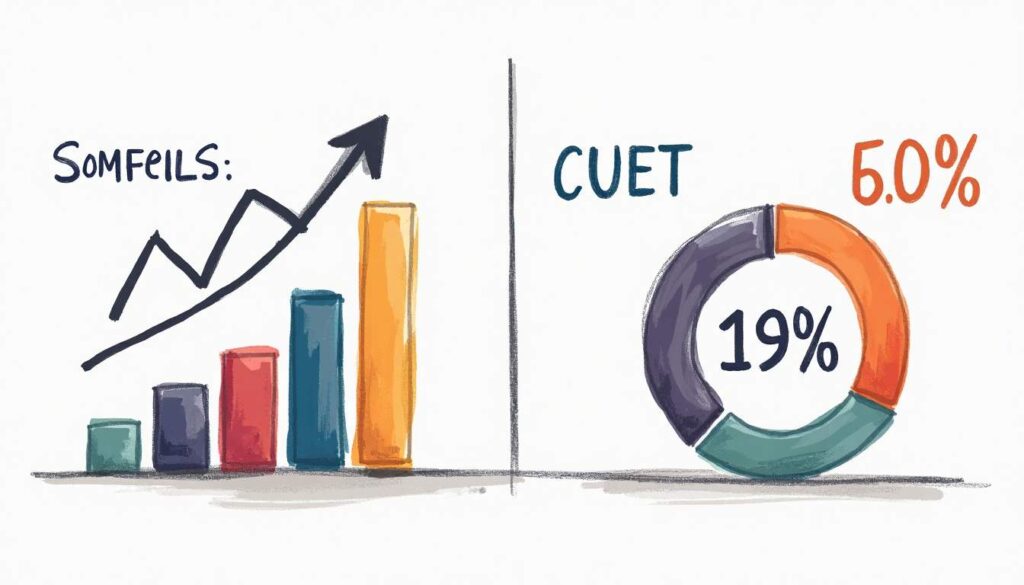Table of Contents
The Common University Entrance Test (CUET) for Postgraduate courses has emerged as a pivotal assessment for students aiming to secure admission in various universities across India. As aspirants navigate through this competitive landscape, understanding the nuances of CUET PG scores and percentiles becomes essential. This article delves into the differences between CUET PG score vs percentile, their implications for students, and how they can impact admission decisions.
What is CUET PG Score?
The CUET PG score represents the raw marks obtained by a candidate in the examination. This score is calculated based on the total number of correct answers, with negative marking applied for incorrect responses. The CUET PG score serves as a direct reflection of a candidate’s performance in the exam.

Components of the CUET PG Score
Understanding the components that contribute to the CUET PG score is crucial for candidates. The score is primarily derived from:
- Correct Answers: Each correct answer contributes positively to the total score.
- Incorrect Answers: A negative marking scheme deducts marks for incorrect answers, impacting the final score.
- Unattempted Questions: Questions that are not attempted do not affect the score.
This scoring system ensures that candidates are rewarded for accuracy while being penalized for guessing. Thus, a strategic approach to answering questions can significantly influence the final CUET PG score. Candidates are often advised to carefully read each question and eliminate obviously incorrect options before making an educated guess, as this can help minimize the risk of losing marks due to negative marking.
Importance of CUET PG Score
The CUET PG score plays a vital role in the admission process. It is the primary criterion used by universities to shortlist candidates for various postgraduate programs. A higher score can enhance a candidate’s chances of securing admission to their preferred institution and program, making it imperative for aspirants to perform well in the examination. Additionally, the score can also impact scholarship opportunities and funding options available to students, as many institutions consider CUET PG scores when allocating financial aid. This adds another layer of significance to the score, as it can influence not just admission but also the financial feasibility of pursuing higher education.
Moreover, the CUET PG score is not only a measure of academic ability but also an indicator of a candidate’s preparedness for advanced studies. A strong performance can reflect a solid understanding of the subject matter, critical thinking skills, and the ability to apply knowledge in practical scenarios. As such, universities may use the CUET PG score as part of a holistic evaluation process, considering it alongside other factors such as personal statements, letters of recommendation, and interviews to gauge a candidate’s overall fit for their programs.
Understanding Percentiles
While the CUET PG score reflects an individual’s performance, the percentile offers a comparative perspective. A percentile indicates the percentage of candidates who scored below a particular score. For instance, if a candidate is in the 90th percentile, it means they performed better than 90% of the candidates who took the exam. This comparative measure is essential in understanding not just how well a candidate did, but how they stand in relation to their peers, providing a broader context to their achievements.
How Percentiles are Calculated
Calculating percentiles involves a straightforward formula. The formula for determining a candidate’s percentile is as follows:
Percentile = (Number of candidates with a score less than the candidate’s score / Total number of candidates) × 100
This calculation provides a clearer picture of a candidate’s standing relative to their peers. It is particularly useful in competitive exams where many candidates may achieve similar scores, allowing for a more nuanced selection process. Additionally, understanding the distribution of scores can help candidates gauge their performance in a more meaningful way, as it highlights the competitiveness of the exam and the caliber of their fellow test-takers.
Significance of Percentiles in Admissions
Percentiles are crucial in the admission process as they help universities create a merit list. Institutions often use percentiles to rank candidates, especially when multiple students achieve similar CUET PG scores. This ranking can be a deciding factor in admissions, particularly for programs with limited seats. Furthermore, the use of percentiles can also help institutions identify candidates who not only excel academically but also demonstrate a strong competitive edge, which is often a key attribute sought by many programs.
Moreover, the reliance on percentiles allows universities to maintain a level of fairness in their admissions process. By using a standardized measure, institutions can ensure that candidates are evaluated on a common scale, reducing biases that might arise from varying grading systems across different educational backgrounds. This method also encourages students to strive for higher performance, knowing that their scores will be compared against a broader pool of candidates, thereby fostering a culture of excellence and motivation in academic pursuits.
CUET PG Score vs Percentile: Key Differences
Understanding the differences between CUET PG score vs percentile is essential for candidates as they prepare for the examination and subsequent admissions. Here are some key distinctions:

Nature of Measurement
The CUET PG score is an absolute measure of performance, reflecting the actual marks obtained in the exam. In contrast, the percentile is a relative measure, indicating a candidate’s performance in relation to others. This distinction is fundamental, as it highlights that a high score does not always guarantee a high percentile, especially in a competitive environment. For instance, if a candidate scores 90 out of 100 but the overall performance of the cohort is exceptionally high, their percentile may still be lower than expected. Understanding this dynamic can help candidates set realistic expectations and strategies for their preparation.
Implications for Candidates
For candidates, both the CUET PG score vs percentile have unique implications. A high score may boost confidence and enhance admission prospects, but a low percentile could indicate that many candidates performed exceptionally well. Conversely, a lower score with a high percentile could suggest that the overall performance of candidates was not as strong, which can be a point of reassurance for applicants. Additionally, candidates should consider how their scores and percentiles may affect scholarship opportunities or eligibility for specific programs, as some institutions may have varying criteria based on these metrics.
Usage in Admission Processes
Universities typically prioritize CUET PG scores for initial shortlisting but may rely on percentiles for final admissions. This dual approach allows institutions to maintain a fair selection process, ensuring that candidates are evaluated both on their individual merits and their performance relative to peers. Furthermore, understanding how different universities interpret these metrics can be crucial; some may weigh scores more heavily in certain disciplines while others might focus on percentiles to ensure a diverse and competitive cohort. This nuanced understanding can empower candidates to tailor their applications and prepare strategically for their desired programs.
Implications of CUET PG Scores and Percentiles
The implications of CUET PG score vs percentiles extend beyond mere numbers; they can significantly influence a candidate’s academic journey and future opportunities. Here are some of the key implications:

Impact on Admission Opportunities
For many candidates, the ultimate goal of taking the CUET PG is to gain admission into a reputable postgraduate program. A strong CUET PG score can open doors to prestigious institutions, while a high percentile can enhance a candidate’s standing in the admission process. This duality of scores and percentiles means that candidates must strive for excellence in both areas to maximize their chances of success.
Future Academic and Career Prospects
Admission into a quality postgraduate program can have lasting effects on a candidate’s academic and professional trajectory. Graduates from esteemed institutions often enjoy better job prospects and higher earning potential. Therefore, understanding the importance of CUET PG scores and percentiles can motivate candidates to prepare thoroughly and perform to the best of their abilities.
Strategic Preparation for the Exam
Recognizing the significance of both CUET PG score vs percentile can influence how candidates approach their exam preparation. Focusing solely on achieving a high score may lead to neglecting the broader context of percentile rankings. Candidates should adopt a balanced study strategy that emphasizes both accuracy and comprehensive understanding of the subject matter, ensuring they are well-prepared for the competitive nature of the exam.
Preparing for CUET PG: Tips and Strategies
Preparation for the CUET PG requires a well-structured approach. Here are some effective tips and strategies to help candidates excel:
Understand the Syllabus and Exam Pattern
Familiarity with the syllabus and exam pattern is crucial. Candidates should review the topics covered in the CUET PG and understand the weightage of different sections. This knowledge allows for targeted preparation, ensuring that candidates allocate their study time effectively.
Practice Regularly with Mock Tests
Regular practice through mock tests is essential for building confidence and improving time management skills. Mock tests simulate the exam environment, helping candidates familiarize themselves with the format and pressure of the actual test. Analyzing performance in these tests can also highlight areas that require additional focus.
Seek Guidance and Resources
Utilizing study materials, online resources, and guidance from mentors can significantly enhance preparation efforts. Joining study groups or coaching classes can provide additional support and motivation, fostering a collaborative learning environment. Engaging with peers can also facilitate knowledge sharing and problem-solving.
Conclusion
In conclusion, understanding the differences between CUET PG score vs percentile is crucial for candidates navigating the competitive landscape of postgraduate admissions. Both metrics serve distinct purposes, with scores reflecting individual performance and percentiles providing a comparative perspective. As candidates prepare for the CUET PG, they must recognize the implications of these measurements on their academic and career prospects.
By adopting strategic preparation methods and focusing on both CUET PG score vs percentiles, candidates can enhance their chances of success in securing admission to their desired programs. Ultimately, a comprehensive understanding of these concepts will empower candidates to approach the CUET PG with confidence and clarity.
Take Your CUET PG Preparation to the Next Level with OptimizedCalc
Ready to elevate your CUET PG exam preparation? Let OptimizedCalc be your ally on this journey. Our platform offers an array of advanced calculation tools tailored to support your academic endeavors. From understanding complex concepts to practicing with precision, OptimizedCalc is here to help you optimize your study sessions. Don’t just aim for a high score; aim for a top percentile with the right tools at your fingertips. Explore Tools on OptimizedCalc and take the first step towards a successful CUET PG outcome.
We hope this guide helped you understand the CUET PG Score vs Percentile and how it impacts your admission journey.